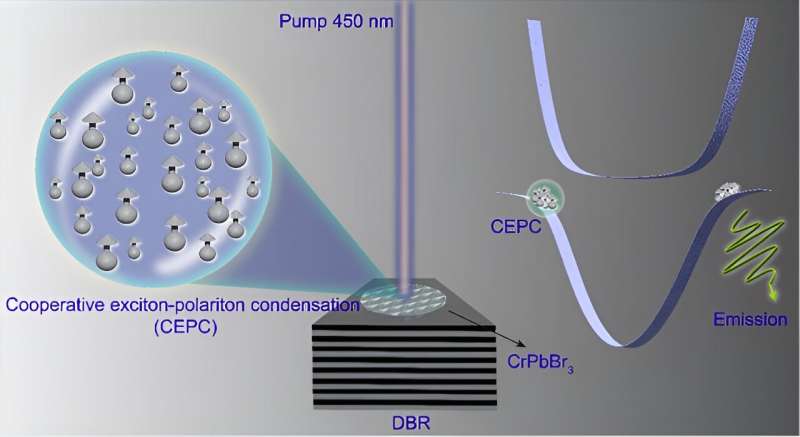This article has been reviewed according to Science X's editorial process and policies. Editors have highlighted the following attributes while ensuring the content's credibility:
fact-checked
peer-reviewed publication
trusted source
proofread
Team creates cooperative exciton-polariton condensate

Superfluorescence (SF), as a cooperative radiation effect originating from vacuum quantum fluctuations, is an ideal platform for studying many-body correlation mechanisms in an exciton ensemble, and for developing optically ultrafast techniques on bright quantum light sources. Recently, the observations of superfluorescence effects based on different radiative materials or under different working temperatures have been a hot topic. However, current works mainly focus on studying and discussing the establishment of SF itself.
In a new paper published in Light: Science & Applications, a team of scientists, led by Professor Zheng Sun and Professor Wei Xie and colleagues from the State Key Laboratory of Precision Spectroscopy, East China Normal University in Shanghai have proposed the development of the superfluorescence field in combination with the research field of polaritons.
Explicitly, they claim for the first time not only to observe the superfluorescence effect but also to control the collective state of the dipole ensemble by including a new regulatory dimension of coupling light fields. Their experimental and theoretical work, described in this paper, gives strong evidence for revealing a new quasi-particle of cooperative exciton-polariton (CEP) and the phase transition from superfluorescence to CEP condensation.
They demonstrate a light-matter hybrid structure of a perovskite quantum dot film and a simple half-layer Bragg mirror. The cooperative exciton-polariton is formalized by coupling an ensemble of synchronized exctions to a selected optical Bragg mode. Above the density threshold, condensation occurs at a nonzero momentum state on the lower polariton branch due to the vital role of cooperative exctions. The phase transition exhibits key signatures of a decrease of the line width, an increase of the macroscopic coherence as well as an accelerated radiative decay rate.
The scientists summarize the underlying physical mechanism for the phase transition from the superfluorescence to CEP condensation of their hybrid structure: "We demonstrate the strong coupling between the cooperative excitons and Bragg photons in a perovskite QDs-based half cavity with a Rabi splitting of 21.6 meV."
"We achieve the cooperative exciton-polariton condensation. The involved correlated excitons have proven to considerably enhance the coupling strength, which can be attributed to the cooperative effect inducing the synchronization of the random phases of the exciton to be aligned to form a giant dipole. Hence, it allows condensation to take place beyond what is possible at the individual QD level," they add.
"The present demonstration of the new quasiparticle condensation enables new potential applications for developing ultra-narrow tunable lasers. Additionally, the possibility of controlling the condensation flow and hence exploiting it as the building blocks for various optoelectronic devices is another exciting field offered by such a perovskite QDs system," the team says.
More information: Danqun Mao et al, Observation of transition from superfluorescence to polariton condensation in CsPbBr3 quantum dots film, Light: Science & Applications (2024). DOI: 10.1038/s41377-024-01378-5
Journal information: Light: Science & Applications
Provided by Chinese Academy of Sciences





















